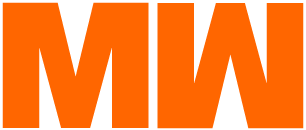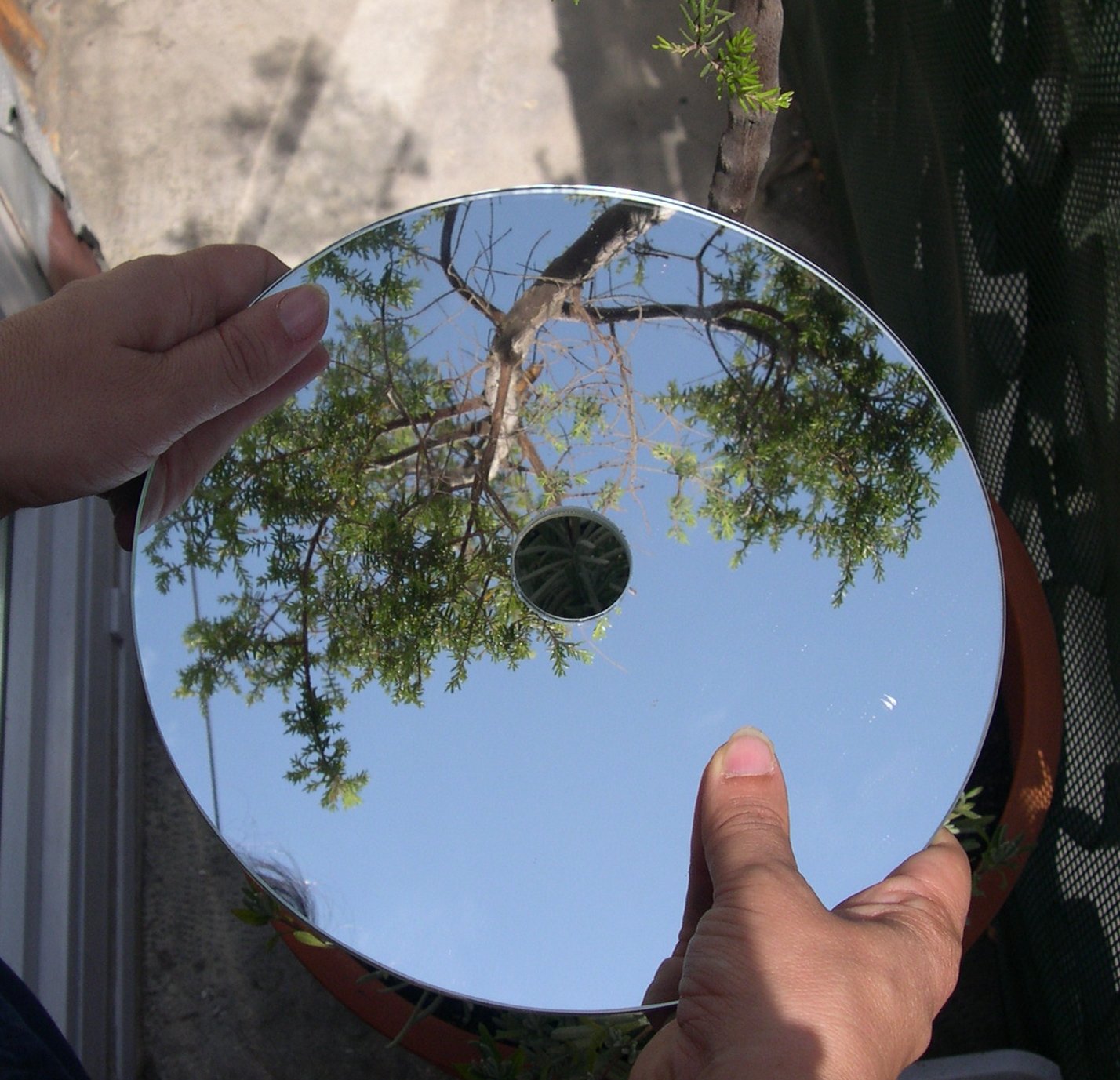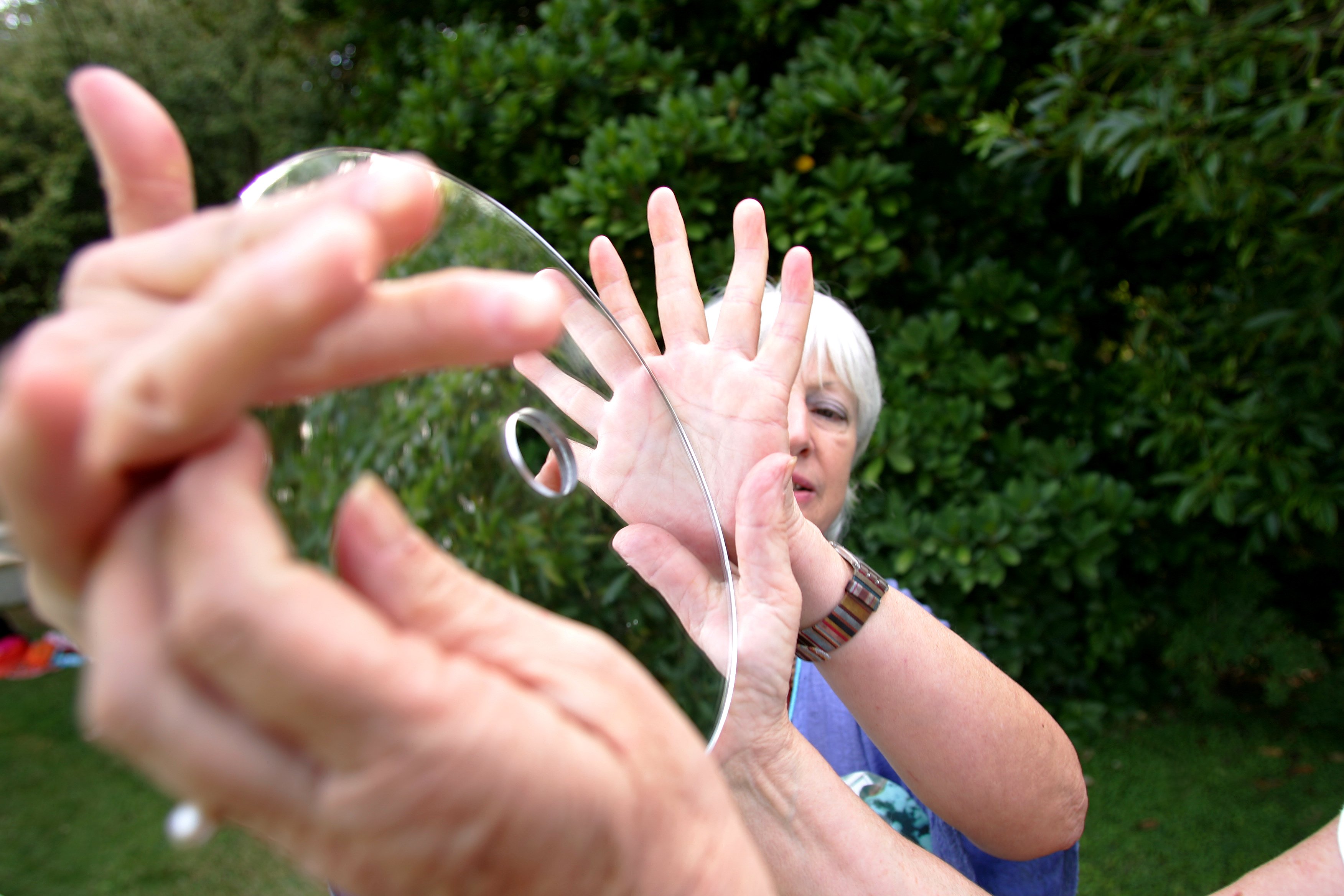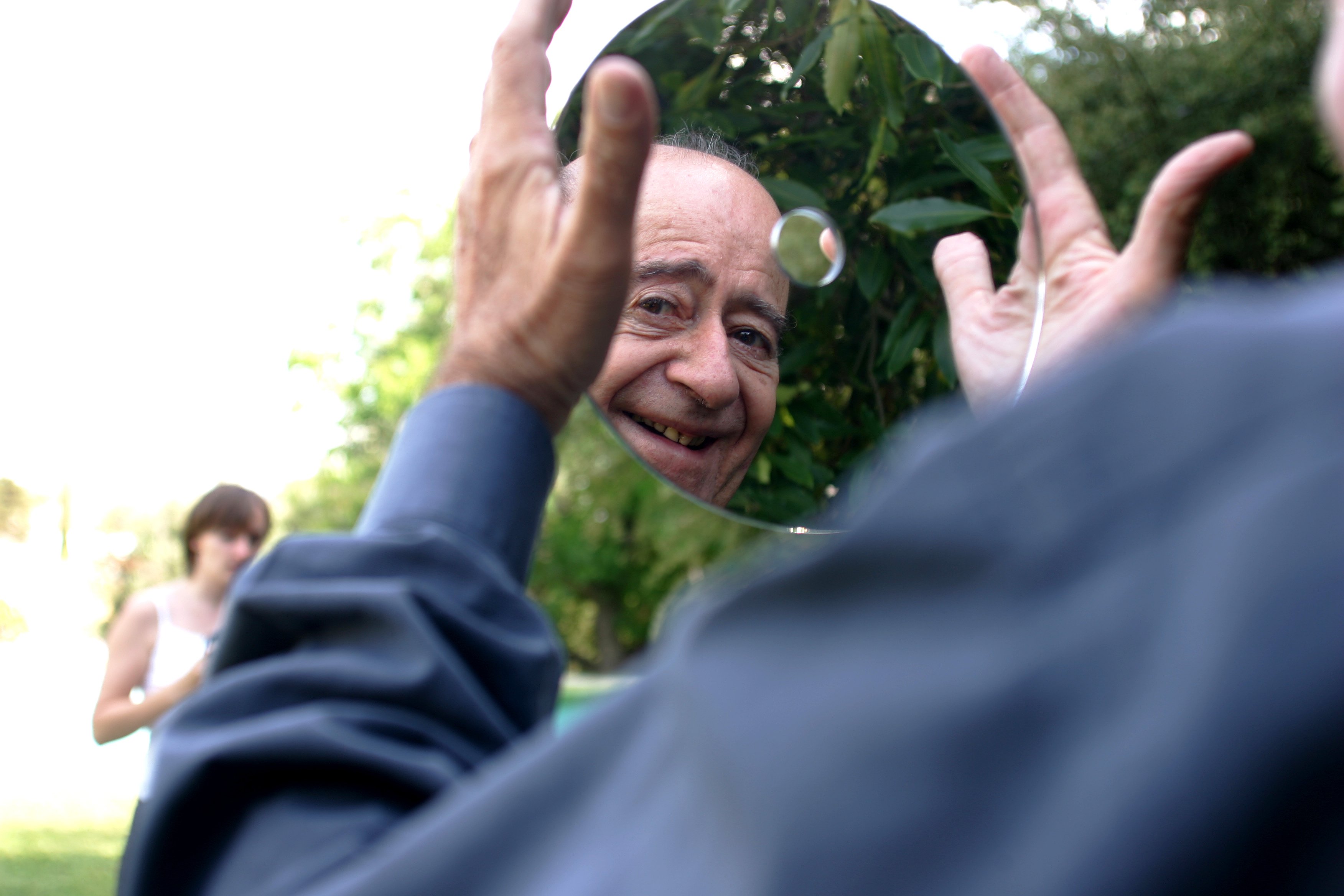Diâmetro 22 x 3cm
Acrílico espelhado
1/3 Fundação de Arte Moderna e Contemporânea, colecção Berardo.
Instruções de uso Olho# 1 (para ser usado no exterior à luz do dia):
Escolha um espaço que permita uma acção – trajecto um passeio. A escolha da envolvente é importante.
Agarre o objecto Olho# 1 à altura dos olhos e caminhe.
Em movimento a envolvente e o auto-retrato vão reflectir-se no espelho e comunicar com o que podemos ver através da
fenda circular.
ENTRAR EM CONTEMPLAÇÃO, ENTRAR NUM RITUAL, ENTRAR EM FESTA (A alegria).
O Olho #1 é um objecto para ser agarrado pelas duas mãos e ser colocado à altura dos olhos de quem o transporta.
O espelho traz à presença, a representação no espelho é feita pela presença, facto incontornável. No entanto, não pode representar o todo pois não pode duplicar a representação no que diz respeito à recriação da tri-dimensão. Ainda que tenha uma carácter especulativo – também nele há reflexo, o Olho não se esgota na reflexão especular, porque abre uma janela, rompe o carácter fechado de opacidade do espelho abrindo uma fenda, um vazio, um buraco nu, um atravessar possível para o outro lado do espelho, como desejou Alice. Assim o Olho #1 é um objecto-acção. Propõe um trajecto e uma envolvente.
O movimento, proposta fundamental nesta obra, não é representado na peça mas é a construção da peça. Esta celebra-o. O Olho é um objecto que é transportado e que transporta. E abre a possibilidade de olhar em todas as direcções. Indo para lá da ideia frente – trás de Pistoletto – o espelho e a inversão da perspectiva: o mundo que nós vemos no espelho encontra-se nas nossas costas, basta dar meia volta e prosseguir caminho nessa direcção. No Olho #1 não há esta oposição visto que transportamos connosco o espelho.
O Olho #1, enquanto objecto a ser colocado diante dos olhos, é sempre primeiro que tudo um (auto)-retrato, no entanto, ao ser móvel, implica uma multiplicidade de (auto)-retratos. Para além disso este (auto)-retrato é intersectado pelo mundo (tudo aquilo que estiver na perspectiva da fenda) e nesse sentido este torna-se imagem desta realidade, eu e intersecção, retrato e mundo que o circunda num circuito aberto.
A referência primordial é a da utilização do espelho e da viragem que o uso deste material permitiu na evolução da sua obra. No tanto se Olho #1 também incorpora o deslumbramento do poder reflexivo do espelho (que para um pintor terá sempre uma maior magia porque joga com o grande binómio da história da pintura – bi-tridimensão ou vice-versa) mas vai para lá da problemática da representação acrescentando sobretudo dois pontos fundamentais:
1. O plano natural do infinito (refiro-me ao buraco aberto no espelho) – a própria ideia de abertura no espelho que nos remete para a natureza da visão (ver-olhar), ou espelho que se transforma pela abertura desta fenda ou lugar em moldura (refiro-me ao espelho enquanto contorno desta abertura) abrindo assim mais uma perspectiva de reflexão.
2. A introdução da locomoção (refiro-me à transformação da superfície quadro espelhado num objecto para ser transportável e por sua vez a visão em movimento que a sua deslocação nos permite). Se imaginarmos o espanto aquando da introdução do espelho no plano do quadro-pintura pudemos imaginar o espanto do desdobramento infinito que trouxe a co-existência de todos estes planos. Pois não se trata da ilusão do vidro na construção da perspectiva, mas da coicidência e intersecção do plano de trás – a superfície especular e o plano da perspectiva a olho nu. A invenção ou a descoberta do Olho nasce então da intersecção do plano do espelho e do plano do infinito (abertura) a essa intersecção dei o nome de membrana. Esta membrana que é realmente o Olho é um espaço vivo e lactente.
As características desde espaço dá-se por oposições. O facto do plano que enquadra a abertura ser estático embora reflexivo faz com que o buraco pareça de uma estranha densidade. Por outro lado, o espelho mesmo que num plano estático ao reflectir, mostra-nos o plano que corresponde quando estamos a olhar para este, as nossas costas, e a fenda mostra-nos o que está para lá da superfície do espelho e que nesse sentido corresponde ao que está à nossa frente num plano do infinito. Mas a membrana Olho neste contraste frente-trás e na intersecção dos movimentos possíveis forma um plano que diria vivo porque parece ter o seu próprio latejar. Esse plano não pertence nem ao espelho nem há perspectiva da fenda. Esta fenda cruza assim duas naturezas do olhar que embora cada uma por si só corresponda de uma realidade a que estamos habituados: por um lado o reflexo de espelho ou, por outro, a vista a olho nu. E cria uma outra que não tem nome, não sendo nem espelho, nem vidro, nem infinito. É uma experiência óptica que dá ênfase à nudez do olhar, não se tratando de uma metáfora.
Diameter: 22 x 3cm
Mirrored Acrylic
1/3 Foundation for Modern and Contemporary Art, Berardo Collection
Instructions for use (to be used outdoors in daylight):
Select a space where it is possible to perform a trajectory-action, a stroll. The choice of the surroundings is important.
Hold the object Eye# 1 at eye level and walk.
With the movement, the surroundings and the self-portrait will reflect themselves in the mirror and communicate with what can be seen through the circular opening.
ENGAGE IN CONTEMPLATION, ENGAGE IN A RITUAL, ENGAGE IN A PARTY (The hapiness)
Olho #1 (Eye #1) is an object to be grabbed by the two hands and put at the carrier’s eye level.
The mirror brings to presence, the representation of the mirror is done by the presence, unavoidable fact. However, it cannot represent the whole, because it cannot duplicate the representation which concerns the creation of the third dimension.
Despite its speculative character – in it there is also reflection – Olho (Eye) is not depleted by such a speculated reflection, because it opens a window, breaking through the close character of the mirror’s opacity, opening a fissure, an emptiness, a naked hole, a possible crossing to the other side, as Alice wished for. Thus, Olho #1 (Eye #1) is an object-action.
It proposes a trajectory and a surrounding. The movement, fundamental proposal in this work, is not represented in the piece but it is the construction of the piece It celebrates it. The Olho (Eye) is an object which carries and is carried. And it gives the possibility of looking in all directions. Going beyond Pistoletto’s notion of front-back, the mirror and the inversion of perspective: “the world that we see on the mirror is behind our backs, it is enough to turn around and continue along that direction”. In Olho #1 (Eye #1) there is not such an opposition, since we carry the mirror with us.
Olho #1 (Eye #1), as an object, to be set in front of one’s eyes, is always first of all a (self ) portrait, however, being mobile, it implies a multiplicity of (self-) portraits. In addition, this (self) portrait is intersected by the world (everything within the fissure’s perspective), and in that sense it becomes an image of reality, self and intersection, portrait and the surrounding world in an open circuit. The primordial reference is the one of the use of the mirror4 and the turning point that the use of this material conceded in the evolution of its work. Despite the Olho #1’s (Eye #1) incorporation of the amazement of the reflective power of the mirror (which, for a painter, will always have a greater magic because it plays with the great historical binomial of painting – two – three dimensionality, or vice versa), it also goes beyond the problematics of representation mainly by adding two fundamental aspects:
1. The natural plane at infinity (meaning the open hole in the mirror) – the very own idea of an opening in the mirror which leads us to the nature of vision (to see- to look), or mirror which is transformed by this opening, or place in a frame (the mirror as contour of this opening), thus enabling one more perspective of reflection.
2. The introduction of locomotion (the transformation of the mirrored surface painting into an object to be carried, and vision into movement, enabled by the displacement). If we imagine the amazement of the introduction of the mirror in the plane canvas-painting, we can imagine the amazement of the infinite unfolding that brought the co-existence of all these planes. Because we are not dealing with the glass’ illusion in the construction of perspective, but with the coincidence and intersection of the back plane – the speculated surface- and the perspective’s plane for the naked eye. The invention or discovery of Olho (Eye) has its roots on the intersection between the mirror’s plane and the plane at infinity (opening), an intersection that named membrane. This membrane, that the Olho is, is a living and nurseling space. This space’s characteristics are given by opposition. The fact that the plane which frames the opening is static, though reflexive, makes the hole of a strange density.
On the other hand, the mirror, even in a static plane while reflecting, shows us the plane which answers back, when we look to it, showing our backs, and the crack shows us what is beyond the mirror’s surface and that, in this sense, is in front of us in a plane at infinity. But the membrane Olho (Eye), in this contrast front-back and in the intersection of the possible movements, forms a plane, and I would add a living plane, because it seems to have its own pulsation. This plane belongs neither to the mirror nor to the fissure’s perspective.
Consequently, the hole crosses two natures of the regard, each one corresponding to a reality we are used to: on the one hand, mirror’s reflection; on the other the naked eyes view. And it creates one nameless other, not being neither mirror, nor glass, nor infinite. It is an optical experience that emphasizes the nakedness of the eye, not in a metaphorical way.
- + PT
-
Diâmetro 22 x 3cm
Acrílico espelhado1/3 Fundação de Arte Moderna e Contemporânea, colecção Berardo.
Instruções de uso Olho# 1 (para ser usado no exterior à luz do dia):
Escolha um espaço que permita uma acção – trajecto um passeio. A escolha da envolvente é importante.
Agarre o objecto Olho# 1 à altura dos olhos e caminhe.
Em movimento a envolvente e o auto-retrato vão reflectir-se no espelho e comunicar com o que podemos ver através da
fenda circular.ENTRAR EM CONTEMPLAÇÃO, ENTRAR NUM RITUAL, ENTRAR EM FESTA (A alegria).
O Olho #1 é um objecto para ser agarrado pelas duas mãos e ser colocado à altura dos olhos de quem o transporta.
O espelho traz à presença, a representação no espelho é feita pela presença, facto incontornável. No entanto, não pode representar o todo pois não pode duplicar a representação no que diz respeito à recriação da tri-dimensão. Ainda que tenha uma carácter especulativo – também nele há reflexo, o Olho não se esgota na reflexão especular, porque abre uma janela, rompe o carácter fechado de opacidade do espelho abrindo uma fenda, um vazio, um buraco nu, um atravessar possível para o outro lado do espelho, como desejou Alice. Assim o Olho #1 é um objecto-acção. Propõe um trajecto e uma envolvente.
O movimento, proposta fundamental nesta obra, não é representado na peça mas é a construção da peça. Esta celebra-o. O Olho é um objecto que é transportado e que transporta. E abre a possibilidade de olhar em todas as direcções. Indo para lá da ideia frente – trás de Pistoletto – o espelho e a inversão da perspectiva: o mundo que nós vemos no espelho encontra-se nas nossas costas, basta dar meia volta e prosseguir caminho nessa direcção. No Olho #1 não há esta oposição visto que transportamos connosco o espelho.
O Olho #1, enquanto objecto a ser colocado diante dos olhos, é sempre primeiro que tudo um (auto)-retrato, no entanto, ao ser móvel, implica uma multiplicidade de (auto)-retratos. Para além disso este (auto)-retrato é intersectado pelo mundo (tudo aquilo que estiver na perspectiva da fenda) e nesse sentido este torna-se imagem desta realidade, eu e intersecção, retrato e mundo que o circunda num circuito aberto.
A referência primordial é a da utilização do espelho e da viragem que o uso deste material permitiu na evolução da sua obra. No tanto se Olho #1 também incorpora o deslumbramento do poder reflexivo do espelho (que para um pintor terá sempre uma maior magia porque joga com o grande binómio da história da pintura – bi-tridimensão ou vice-versa) mas vai para lá da problemática da representação acrescentando sobretudo dois pontos fundamentais:
1. O plano natural do infinito (refiro-me ao buraco aberto no espelho) – a própria ideia de abertura no espelho que nos remete para a natureza da visão (ver-olhar), ou espelho que se transforma pela abertura desta fenda ou lugar em moldura (refiro-me ao espelho enquanto contorno desta abertura) abrindo assim mais uma perspectiva de reflexão.
2. A introdução da locomoção (refiro-me à transformação da superfície quadro espelhado num objecto para ser transportável e por sua vez a visão em movimento que a sua deslocação nos permite). Se imaginarmos o espanto aquando da introdução do espelho no plano do quadro-pintura pudemos imaginar o espanto do desdobramento infinito que trouxe a co-existência de todos estes planos. Pois não se trata da ilusão do vidro na construção da perspectiva, mas da coicidência e intersecção do plano de trás – a superfície especular e o plano da perspectiva a olho nu. A invenção ou a descoberta do Olho nasce então da intersecção do plano do espelho e do plano do infinito (abertura) a essa intersecção dei o nome de membrana. Esta membrana que é realmente o Olho é um espaço vivo e lactente.
As características desde espaço dá-se por oposições. O facto do plano que enquadra a abertura ser estático embora reflexivo faz com que o buraco pareça de uma estranha densidade. Por outro lado, o espelho mesmo que num plano estático ao reflectir, mostra-nos o plano que corresponde quando estamos a olhar para este, as nossas costas, e a fenda mostra-nos o que está para lá da superfície do espelho e que nesse sentido corresponde ao que está à nossa frente num plano do infinito. Mas a membrana Olho neste contraste frente-trás e na intersecção dos movimentos possíveis forma um plano que diria vivo porque parece ter o seu próprio latejar. Esse plano não pertence nem ao espelho nem há perspectiva da fenda. Esta fenda cruza assim duas naturezas do olhar que embora cada uma por si só corresponda de uma realidade a que estamos habituados: por um lado o reflexo de espelho ou, por outro, a vista a olho nu. E cria uma outra que não tem nome, não sendo nem espelho, nem vidro, nem infinito. É uma experiência óptica que dá ênfase à nudez do olhar, não se tratando de uma metáfora.
- + EN
-
Diameter: 22 x 3cm
Mirrored Acrylic1/3 Foundation for Modern and Contemporary Art, Berardo Collection
Instructions for use (to be used outdoors in daylight):
Select a space where it is possible to perform a trajectory-action, a stroll. The choice of the surroundings is important.
Hold the object Eye# 1 at eye level and walk.
With the movement, the surroundings and the self-portrait will reflect themselves in the mirror and communicate with what can be seen through the circular opening.ENGAGE IN CONTEMPLATION, ENGAGE IN A RITUAL, ENGAGE IN A PARTY (The hapiness)
Olho #1 (Eye #1) is an object to be grabbed by the two hands and put at the carrier’s eye level.
The mirror brings to presence, the representation of the mirror is done by the presence, unavoidable fact. However, it cannot represent the whole, because it cannot duplicate the representation which concerns the creation of the third dimension.
Despite its speculative character – in it there is also reflection – Olho (Eye) is not depleted by such a speculated reflection, because it opens a window, breaking through the close character of the mirror’s opacity, opening a fissure, an emptiness, a naked hole, a possible crossing to the other side, as Alice wished for. Thus, Olho #1 (Eye #1) is an object-action.
It proposes a trajectory and a surrounding. The movement, fundamental proposal in this work, is not represented in the piece but it is the construction of the piece It celebrates it. The Olho (Eye) is an object which carries and is carried. And it gives the possibility of looking in all directions. Going beyond Pistoletto’s notion of front-back, the mirror and the inversion of perspective: “the world that we see on the mirror is behind our backs, it is enough to turn around and continue along that direction”. In Olho #1 (Eye #1) there is not such an opposition, since we carry the mirror with us.
Olho #1 (Eye #1), as an object, to be set in front of one’s eyes, is always first of all a (self ) portrait, however, being mobile, it implies a multiplicity of (self-) portraits. In addition, this (self) portrait is intersected by the world (everything within the fissure’s perspective), and in that sense it becomes an image of reality, self and intersection, portrait and the surrounding world in an open circuit. The primordial reference is the one of the use of the mirror4 and the turning point that the use of this material conceded in the evolution of its work. Despite the Olho #1’s (Eye #1) incorporation of the amazement of the reflective power of the mirror (which, for a painter, will always have a greater magic because it plays with the great historical binomial of painting – two – three dimensionality, or vice versa), it also goes beyond the problematics of representation mainly by adding two fundamental aspects:
1. The natural plane at infinity (meaning the open hole in the mirror) – the very own idea of an opening in the mirror which leads us to the nature of vision (to see- to look), or mirror which is transformed by this opening, or place in a frame (the mirror as contour of this opening), thus enabling one more perspective of reflection.
2. The introduction of locomotion (the transformation of the mirrored surface painting into an object to be carried, and vision into movement, enabled by the displacement). If we imagine the amazement of the introduction of the mirror in the plane canvas-painting, we can imagine the amazement of the infinite unfolding that brought the co-existence of all these planes. Because we are not dealing with the glass’ illusion in the construction of perspective, but with the coincidence and intersection of the back plane – the speculated surface- and the perspective’s plane for the naked eye. The invention or discovery of Olho (Eye) has its roots on the intersection between the mirror’s plane and the plane at infinity (opening), an intersection that named membrane. This membrane, that the Olho is, is a living and nurseling space. This space’s characteristics are given by opposition. The fact that the plane which frames the opening is static, though reflexive, makes the hole of a strange density.
On the other hand, the mirror, even in a static plane while reflecting, shows us the plane which answers back, when we look to it, showing our backs, and the crack shows us what is beyond the mirror’s surface and that, in this sense, is in front of us in a plane at infinity. But the membrane Olho (Eye), in this contrast front-back and in the intersection of the possible movements, forms a plane, and I would add a living plane, because it seems to have its own pulsation. This plane belongs neither to the mirror nor to the fissure’s perspective.
Consequently, the hole crosses two natures of the regard, each one corresponding to a reality we are used to: on the one hand, mirror’s reflection; on the other the naked eyes view. And it creates one nameless other, not being neither mirror, nor glass, nor infinite. It is an optical experience that emphasizes the nakedness of the eye, not in a metaphorical way.






